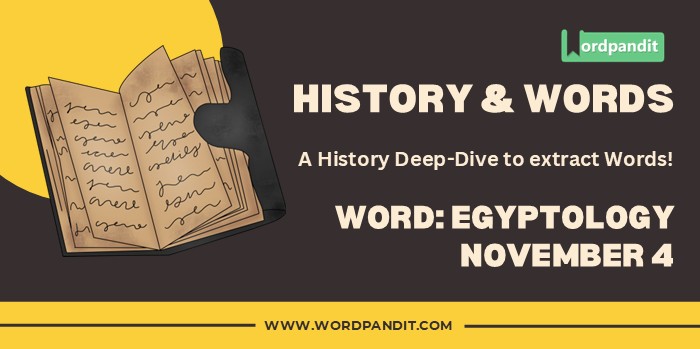History & Words: 'Egyptology' (November 4)
Welcome to 'History & Words.' 🌟 I'm Prashant, founder of Wordpandit and the Learning Inc. Network. This series combines my passion for language learning with historical context. Each entry explores a word's significance on a specific date, enhancing vocabulary while deepening understanding of history. Join me in this journey of words through time.
📚 Table of Contents
- Word of the Day
- Introduction
- Etymology
- Key Vocabulary
- Historical Context
- Timeline
- The Day's Significance
- Quote
- Modern Usage and Reflection
- Legacy
- Comparative Analysis
- Did You Know?
- Conclusion
- Further Reading
🔍 Word of the Day: Egyptology
Pronunciation: /ˌiːdʒɪpˈtɒlədʒi/ (ee-jip-TOL-uh-jee)
🌍 Introduction
On November 4, 1922, British archaeologist Howard Carter made a discovery that would captivate the world's imagination and transform our understanding of ancient Egypt. After years of searching, Carter found the entrance steps to Tutankhamun's tomb in the Valley of the Kings, leading to what would become one of the most significant archaeological finds in history.
The field of Egyptology, already well-established by 1922, experienced a renaissance following this discovery. The unprecedented preservation of artifacts in Tutankhamun's tomb provided scholars with invaluable insights into ancient Egyptian civilization, from royal burial practices to artistic achievements.
This discovery marked a turning point in archaeological methodology and public engagement with ancient history, demonstrating how careful scientific study could unveil the secrets of a civilization that had fascinated humanity for millennia.
🌱 Etymology
The term "Egyptology" combines "Egypt" (from the Greek "Aigyptos," derived from the ancient Egyptian name for Memphis, "Hwt-ka-Ptah") with the suffix "-ology" (from Greek "logos," meaning "the study of"). The word emerged in the early 19th century alongside the development of scientific archaeology in Egypt.
📖 Key Vocabulary
- 🔑 Hieroglyphics: The formal writing system of ancient Egypt, using pictographic characters
- 🔑 Pharaoh: The title of ancient Egyptian kings, literally meaning "great house"
- 🔑 Necropolis: A large cemetery or burial ground, particularly the ancient Egyptian cities of the dead
- 🔑 Sarcophagus: A stone coffin, often decorated with inscriptions and religious imagery
- 🔑 Stratigraphy: The study of rock layers and layering, crucial in archaeological dating
🏛️ Historical Context
Egyptology as a scientific discipline emerged following Napoleon's Egyptian campaign (1798-1801), which included extensive documentation of ancient monuments and artifacts. The decipherment of hieroglyphics by Jean-François Champollion in 1822 using the Rosetta Stone opened new avenues for understanding ancient Egyptian texts.
The 19th century saw increasing European interest in Egyptian antiquities, leading to both significant discoveries and controversial removal of artifacts to European museums. This period established many of the methodological foundations of modern Egyptology.
By the early 20th century, more systematic approaches to archaeology were being developed, emphasizing careful documentation and preservation rather than mere treasure hunting. Carter's discovery of Tutankhamun's tomb exemplified this new scientific approach.

⏳ Timeline
- 1798: Napoleon's expedition to Egypt begins systematic study of ancient monuments
- 1822: Champollion deciphers hieroglyphics
- 1859: Auguste Mariette establishes the Egyptian Antiquities Service
- 1881: Discovery of the Royal Cache of mummies at Deir el-Bahri
- 1912: Carter begins searching for Tutankhamun's tomb
- 1922: November 4 - Discovery of tomb entrance steps
- 1922: November 26 - First look into tomb's antechamber
- 1923-1932: Systematic excavation and cataloging of tomb contents
- 1925: Howard Carter publishes first volume on the discovery
🌟 The Day's Significance
November 4, 1922, represents the culmination of Carter's persistent search in the Valley of the Kings. The discovery of the tomb steps came after years of methodical exploration, funded by Lord Carnarvon, who had nearly abandoned the project.
The significance of this discovery extends beyond the magnificent artifacts found. It provided unprecedented insights into royal burial practices, ancient Egyptian art, and the historical period of the late 18th Dynasty. The tomb's nearly intact state offered a time capsule of ancient Egyptian civilization.
The discovery also marked a shift in public engagement with archaeology. The worldwide media coverage of the tomb's excavation generated unprecedented public interest in ancient Egypt, creating what became known as "Egyptomania."
💬 Quote
"At first I could see nothing, the hot air escaping from the chamber causing the candle flame to flicker, but presently, as my eyes grew accustomed to the light, details of the room within emerged slowly from the mist, strange animals, statues, and gold - everywhere the glint of gold." - Howard Carter, describing his first look into Tutankhamun's tomb
🔮 Modern Usage and Reflection
Today, Egyptology combines traditional archaeological methods with cutting-edge technology, including satellite imaging, DNA analysis, and 3D modeling. These tools allow researchers to explore sites non-invasively and gather new data from previously studied artifacts.
The field continues to evolve, addressing questions about ancient Egyptian society, technology, and daily life, while also grappling with issues of cultural heritage and artifact preservation.
🏛️ Legacy
The discovery of Tutankhamun's tomb revolutionized our understanding of ancient Egyptian royal burial practices and material culture. Its impact extends beyond academia, influencing popular culture, museum practices, and archaeological methodology.
The field of Egyptology has also contributed significantly to the development of archaeological techniques and conservation practices, setting standards for the scientific study of ancient civilizations.
🔍 Comparative Analysis
While early Egyptology focused primarily on monumental architecture and royal burials, modern studies encompass a broader range of topics, including social history, economics, and environmental archaeology. This evolution reflects broader changes in archaeological practice and historical inquiry.
💡 Did You Know?
🎓 Conclusion
The discovery of Tutankhamun's tomb on November 4, 1922, represents a pivotal moment in the history of Egyptology, transforming both scholarly understanding and public engagement with ancient Egyptian civilization. The field continues to evolve, combining traditional expertise with modern technology to unlock new insights into one of humanity's most fascinating ancient cultures.
📚 Further Reading
- 📘 "The Discovery of the Tomb of Tutankhamun" by Howard Carter
- 📗 "The Rise and Fall of Ancient Egypt" by Toby Wilkinson
- 📙 "The Oxford History of Ancient Egypt" edited by Ian Shaw












